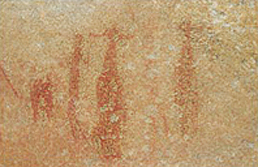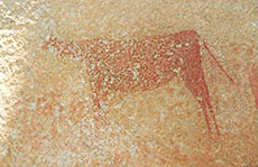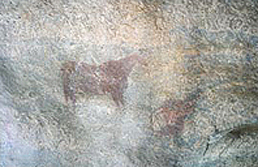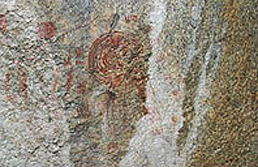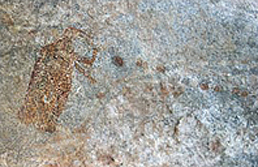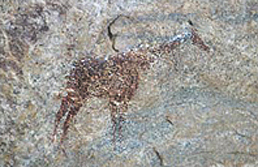 |
 |
Ng’ongo ya Ngimu 1 |
Site 17 |
Singida Region / Singida Rural District / Mgori Division
This is by far the largest and most impressive rock shelter in the Ngimu area, rising to a height of more than 30m from the ground. The name of the village derives from that of the rock shelter, which according to legend, is a lasting tribute to Mr. Ngimu, the first man to settle here. The site is also a sanctuary to a certain clan of the Wanyaturu and is still in use today for propitiatory and ritualistic activities.
The site is located on the northern slopes of the Ngimu hill, which runs in an East-West direction for about a kilometer. Ngimu Primary School is on the southwest foot of the hill. It is a straight-faced rock shelter divided into two parts by a vertical fault line. The painted area of 152.2sq.m makes it the largest in the Singida Iramba rock art belt and, I would presume, possibly the whole of central Tanzania.
The subject matter is quite varied, and includes animals such as giraffe, eland, kudu, buffalo and several antelopes. Also depicted are humans engaged in different activities presumably such as hunting and dancing. In one of the scenes, animals are depicted upside down and enclosed in a circle. Stylistically, all the animals are executed in a bold wash of two shades of red; a scarlet red, and a bright red, producing naturalistic silhouettes. However, no clear order of superpositioning could be detected although there are instances of overlap where the bright red overlies the scarlet red.
Of special interest is the position of the paintings especially as regards their heights from the ground. Some of the paintings are as high up as 10m or more from ground level. The painters must have used some form of scaffolding to paint so high. It seems that special and deliberate efforts were made to locate the paintings so high, but the significance of this is not known although it is quite possible that this has something to do with the value that the painter attached to his paintings; i.e. the higher or the more difficult to reach paintings, the more valuable it is in terms of an aesthetic, or symbolic meaning, or both. Obviously, neither does sympathetic magic nor art for art’s sake can explain why people would go into so much trouble to paint.
Exposed to all natural agents of weathering; direct sun, rain and wind as well as people, the site is in imminent danger of deterioration. The area around the site has been cleared since 1977 for cultivation and this poses a constant risk of vandalism to the site. I strongly recommend that this site should be preserved as it is indeed unique. Although it is, relatively speaking, still in a fairly good state, the deterioration caused mainly by exfoliation is taking place at such a fast rate that unless curative measures are adopted immediately, the site will not be worth visiting ten years from now.
It is also stratified with archaeological deposits, which on the basis of excavations conducted in 1987 by Masao and Liesegang (Masao unpubl.), span a depth of more than two meters and are basically LSA in nature. No Carbon dates for the deposits have as yet been obtained.
 |
 |
Ng’ongo ya Ngimu 2 |
Site 18 |
Singida Region / Singida Rural District / Mgori Division
This site was once part of Ng’ongo ya Ngimu 1, but due to faulting and fracturing, the southern part now stands as an isolated rock shelter. Unlike the latter, which is straight faced, Ngimu 2 has a slight overhang. All the paintings, which would be considered contemporary with those of Ngimu 1 are now completely faded. However, unlike the latter, the paintings are executed in a different shade of red, which is lighter. On the basis of this it is tempting to surmise they may be later than those of Ngimu 1.
The subject matter is predominantly geometrics and symbols, but there are also zebra-like animals, one of which is depicted fallen down. Associated with the fallen animals, is an anthropomorphic figure, which seems to be throwing, possibly bolas or missiles, at the animal. Once again it is tempting to interpret this as a hunting scene, but there are perhaps other equally plausible speculations which future research might discover. Overall the paintings seem to be later than those of Ngimu1. They are in a very good state of preservation. Even discounting the protection offered by the overhang, the paintings are in too good state of preservation to be contemporary with those of Ngimu 1.
→
Rock Art in Tanzania
→
Tanzania Rock Art - Forward by Dr. Meave Leakey
→
Overview of Tanzania Rock Art Sites
→
Tanzania Conservation & Management
→
Tanzania Rock Art Sites|
1-2 |
3-6 |
7-9 |
10-12 |
13-14 |
15-16 |
17-18 |
19-21 |
22-24 |
25-26 |
→
Africa Rock Art Archive
→
Bradshaw Foundation
Like us on Facebook & Follow us on Twitter to receive news & updates:
